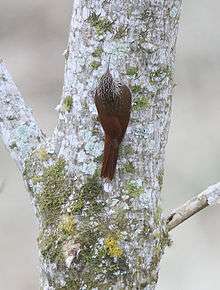Streak-headed woodcreeper
| Streak-headed woodcreeper | |
|---|---|
.jpg) | |
| Scientific classification | |
| Kingdom: | Animalia |
| Phylum: | Chordata |
| Class: | Aves |
| Order: | Passeriformes |
| Family: | Furnariidae |
| Genus: | Lepidocolaptes |
| Species: | L. souleyetii |
| Binomial name | |
| Lepidocolaptes souleyetii (DesMurs, 1849) | |
The streak-headed woodcreeper (Lepidocolaptes souleyetii) is a passerine bird which breeds in the tropical New World from southern Mexico to northwestern Peru, northern Brazil and Guyana, and also on Trinidad.
This woodcreeper is found in lowlands up to 1,500 m (4,900 ft) altitude, although normally below 900 m (3,000 ft), in damp light woodland, plantations, gardens, and clearings with trees. It builds a leaf-lined nest 4.5 to 24 m (15 to 79 ft) up in a tree cavity, or sometimes an old woodpecker hole, and lays two white eggs.
The streak-headed woodcreeper is typically 19 cm (7.5 in) long and weighs 28 g (0.99 oz). It has olive brown upperparts with fine streaking on the crown, nape and upper back, a chestnut rump, wings and tail, and heavily streaked olive-brown underparts. The 2.5 cm (0.98 in) long bill is slender and decurved. Young birds are duller with less distinct streaking.
The call is a sharp rolled djeer and the song is a whistled piiiiiiiiir piiiiiiiiir piiiiiiiiir.
The streak-headed woodcreeper is very similar to the spot-crowned woodcreeper (Lepidocolaptes affinis) but is smaller, has a streaked, not spotted crown, and is found at lower altitudes.
The streak-headed woodcreeper feeds on spiders and insects, creeping up trunks and extracting its prey from the bark or mosses. It is normally seen alone or in a pair and unlike spot-crowned, rarely joins mixed-species feeding flocks.
This species' scientific name commemorates Louis François Auguste Souleyet, French zoologist and naval surgeon.

References
- ↑ BirdLife International (2012). "Lepidocolaptes souleyetii". IUCN Red List of Threatened Species. Version 2013.2. International Union for Conservation of Nature. Retrieved 26 November 2013.
- Stiles, F. Gary; Skutch, Alexander F. (1989). A Guide to the Birds of Costa Rica. Comstock Publishing Associates. ISBN 0-8014-9600-4.
- Hilty, Steven L. (2003). Birds of Venezuela. Princeton University Press. ISBN 0-7136-6418-5.
External links
| Wikimedia Commons has media related to Lepidocolaptes souleyetii. |
| Wikispecies has information related to: Lepidocolaptes souleyetii |
- "Streak-headed woodcreeper media". Internet Bird Collection.
- Streak-headed woodcreeper photo gallery at VIREO (Drexel University)
- Streak-headed woodcreeper species account at NeotropicalBirds (Cornell University)
